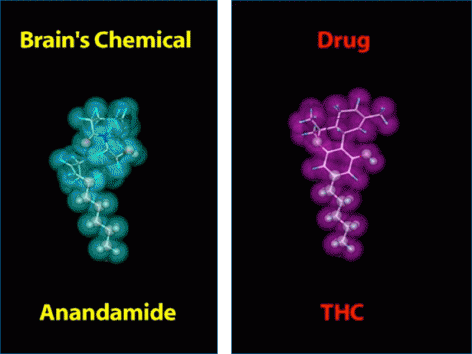DrugFacts: Is Marijuana Medicine?

The use of marijuana to treat various medical conditions—or “medical marijuana”—is a controversial topic and has been for some time. Some people have argued that marijuana’s reported beneficial effects on a variety of symptoms justify its legalization as a medicine for certain patients. Often the potential harm of marijuana use is not considered in these arguments, although risk is part of what the U.S. Food and Drug Administration (FDA) assesses when deciding whether to approve a medicine.
Under Federal law, only FDA-approved medications are legal to prescribe—and marijuana is not one of those. Still, more than a dozen States have approved its use to alleviate a variety of symptoms.
What Does Marijuana Do to the Body?
 Many of marijuana’s effects (including its psychoactive or mind-altering properties) stem from an ingredient called delta-9-tetrahydrocannabinol (THC), which resembles a chemical that the body and brain make naturally (see figure). THC attaches to specialized proteins, called cannabinoid receptors (CBRs), to which the body’s natural chemicals (e.g., anandamide) normally bind.
Many of marijuana’s effects (including its psychoactive or mind-altering properties) stem from an ingredient called delta-9-tetrahydrocannabinol (THC), which resembles a chemical that the body and brain make naturally (see figure). THC attaches to specialized proteins, called cannabinoid receptors (CBRs), to which the body’s natural chemicals (e.g., anandamide) normally bind.
THC’s chemical structure is similar to the brain chemical anandamide. Similarity in structure allows drugs to be recognized by THC’s chemical structure is similar to the brain chemical anandamide. Similarity in structure allows drugs to be recognized by the body and to alter normal brain communication.
CBRs are part of a vast communication network known as the endocannabinoid system (ECS), which plays a role in normal brain development and function. They cluster in brain areas that influence pleasure, memory, thinking, concentration, movement, coordination, and sensory and time perception.
When someone smokes marijuana, THC stimulates the CBRs artificially, disrupting function of the natural cannabinoids. An overstimulation of these receptors in key brain areas produces the marijuana “high” as well as its other effects on mental processes.
Why Isn’t Marijuana an FDA-approved Medicine?
In fact, THC is an FDA-approved medication. It was shown in carefully controlled clinical trials to have therapeutic benefit for relieving nausea associated with cancer chemotherapy and stimulating appetite in patients with wasting syndrome (severe weight loss) that often accompanies AIDS.
However, the scientific evidence to date is not sufficient for the marijuana plant to gain FDA approval, and there are a number of reasons why:
First, there have not been enough clinical trials showing that marijuana’s benefits outweigh its risks in patients with the symptoms it is meant to treat. The FDA requires carefully conducted studies in large numbers of patients (hundreds to thousands) to accurately assess the benefits and risks of a potential medication.
Second, to be considered a legitimate medicine, a substance must have well-defined and measureable ingredients that are consistent from one unit (such as a pill or injection) to the next. This consistency allows doctors to determine the dose and frequency.
What’s the difference between medical and “street” marijuana?
There is no difference between “medical-grade” marijuana and “street” marijuana. The marijuana sold in dispensaries as medicine is the same quality and carries the same health risks as marijuana sold on the street.
Along with THC, the marijuana plant contains over 400 other chemical compounds, including other cannabinoids that may be biologically active and vary from plant to plant. This makes it difficult to consider its use as a medicine even though some of marijuana’s specific ingredients may offer benefits.
Finally, marijuana has certain adverse health effects that also must be taken into account. Because it is usually smoked, marijuana can cause or worsen respiratory symptoms (e.g., bronchitis, chronic cough). It also impairs short-term memory and motor coordination; slows reaction time; alters mood, judgment, and decision-making; and in some people can cause severe anxiety (paranoia) or psychosis (loss of touch with reality). And marijuana is addictive—about 4.5 million people in this country meet clinical criteria for marijuana abuse or dependence.
Misperceptions of Safety Growing acceptance of medical marijuana may be influencing how young people perceive the harm associated with mariju-ana use generally. Research shows that as high school seniors’ perception of marijuana’s risks goes down, their marijuana use goes up, and vice versa (see graph). Surveys show significant recent increases among 10th- and 12th-graders for daily, current, and past-year marijuana use, now surpassing cigarette smoking.
Could Marijuana Be Used in the Creation of FDA-Approvable Medicines?
Yes. Research continues on the possible therapeutic uses of marijuana and its active ingredients. Resulting medications show promise for treating neuropathic pain, addiction, multiple sclerosis, obesity, irritable bowel syndrome, and other conditions.
Learn More
For more information on medical marijuana, visit http://www.drugabuse.gov/publications/research-reports/marijuana-abuse/

